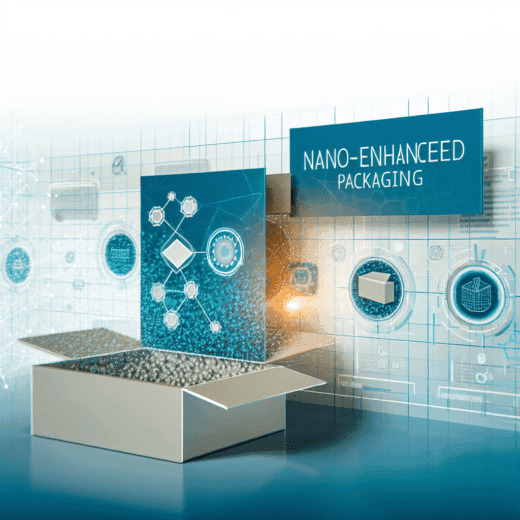Introduction
The intersection of technology and sustainability is reshaping industries, none more so than the packaging sector. Today, with environmental concerns pressing harder on global consciences, nano-enhanced packaging emerges as a game-changer. This innovative approach utilizes nanomaterials to improve packaging durability and sustainability, promising to revolutionize traditional methods and meet the demands of an eco-conscious market. This blog post delves into the transformative potential of this technology, examining its ability to disrupt the market while highlighting the opportunities and challenges unique to startups. Additionally, we explore critical strategies that can propel startups toward success, infused with real-world examples and academic insights.
The Promise of Nano-Enhanced Packaging
Nanotechnology, by manipulating materials at atomic and molecular scales, brings unprecedented enhancements to packaging products. Nanomaterials such as nano-clays, nano-coatings, and carbon nanotubes offer superior barrier properties, increased strength, and reduced weight. This innovation promises not only cost savings in production and transport but also an extended shelf life for packaged goods, thereby reducing waste.
In the context of sustainability, nano-enhanced packaging can significantly reduce the carbon footprint by enabling thinner, lighter structures without compromising protection. According to a report by the European Academy of Sciences, the potential environmental benefits of nanotechnology in packaging are substantial, reducing packaging mass by up to 30%, enhancing recyclability, and minimizing material usage.
Market Disruption and Innovation Potential
The packaging industry operates as a vital cog in global trade, traditionally dominated by large players with entrenched practices. Nano-enhanced packaging, with its myriad of advantages, stands poised to disrupt this long-standing status quo. Startups entering this space have a unique advantage: the ability to innovate without the inertia faced by established firms resistant to change.
Startups can harness this disruption by pioneering novel applications of nanomaterials, potentially redefining packaging standards. The global market for nano-enabled packaging is projected to reach $67 billion by 2024, according to Zenit Research, underscoring the tremendous commercial possibilities. Early adopters in this space have already demonstrated success; for example, NanoPack, a company using natural nanomaterials to extend food shelf life, has shown promising deployment in the food industry while addressing consumer health and environmental safety concerns.
Challenges in Scaling and Achieving Product-Market Fit
Despite its promise, the path to widespread adoption of nano-enhanced packaging isn’t without hurdles. Scaling production, particularly for novel materials, poses significant technical and financial barriers. Nanomaterial production involves complex processes that can be costly and challenging to optimize at an industrial scale.
Startups must also navigate regulatory landscapes that can vary significantly across regions, adding to the complexity of product rollout. For instance, stringent safety evaluations and certifications required in the European Union can delay market entry compared to other regions.
Achieving product-market fit is another challenge, necessitating thorough market research and iterative design processes. Startups must identify niche markets where nano-enhanced features deliver significant advantages over traditional packaging, justifying any premium costs. A success story like that of The Box Company, which developed a nano-enhanced corrugated cardboard solution, illustrates the importance of engaging closely with end-users to iterate the product for optimal performance and cost-efficiency.
Strategies for Startup Growth and Investment
Navigating these challenges demands strategic action, particularly in fundraising and scaling operations. Startups must communicate a compelling vision that aligns innovation with market needs to attract investors. Venture capitalists are increasingly interested in ‘green’ technologies, presenting an opportunity for startups with clear, impact-driven visions.
Effective scaling necessitates partnerships with material scientists and large-scale manufacturers. Collaborative projects, such as BASF’s partnership with the startup Slimy Smarts to develop antimicrobial packaging, highlight the potential of combining expertise to accelerate innovation and market delivery.
Securing early adopters through strategic customer acquisition channels is essential. Crafting a strong go-to-market strategy that leverages digital platforms and emphasizes sustainability credentials can attract environmentally conscious consumers and retailers.
Unique Opportunities in Business Models and Technologies
Nano-enhanced packaging presents unique opportunities for business model innovation. Subscription models or circular economy frameworks, emphasizing recycling and reuse, can provide a sustainable competitive edge. Offering packaging as a service, where businesses pay for usage rather than ownership, could align with the sustainability goals of many modern companies.
Integrating the Internet of Things (IoT) with nano-enhanced solutions offers another intriguing prospect. Smart packaging using nanosensors could provide real-time data on product conditions or freshness, adding a new dimension of value for consumers.
Case Studies: Lessons from Success Stories
Examining successful startups yields invaluable insights. Take the example of Lumi, which revolutionized e-commerce packaging by integrating nano-enhanced inks for brand differentiation and sustainability. By focusing on user experience and the environmental impact, Lumi carved out a competitive niche, securing significant contracts with leading online retailers.
Similarly, AureliusTech’s success in deploying nano-barrier films showcases the power of addressing a specific industry need—in this case, pharmaceuticals demanding stringent anti-counterfeiting measures and enhanced product protection.
The Role of Academic Research and Industry Reports
The cutting-edge nature of nano-enhanced packaging underscores the importance of grounding business strategies in robust research. Academic studies, like those from MIT’s Center for Materials Science and Engineering, provide critical insights into the evolving capabilities and limitations of nanotechnology in practical applications. Industry reports offer strategic data on trends and forecasts, assisting startups in aligning their product development trajectories with market realities.
Conclusion
Nano-enhanced packaging represents a frontier in sustainable innovation, offering startups a rare opportunity to disrupt a mature industry. Success relies on navigating complex challenges through strategic partnerships, robust research, and a keen understanding of market dynamics. Startups that effectively harness the power of nanotechnology and align it with customer demands and environmental priorities are well-positioned to lead the charge in transforming packaging for a sustainable future. As the landscape continues to evolve, ongoing innovation and adaptability will be essential in capitalizing on the vast opportunities at the intersection of nanotechnology and sustainable packaging.

